Maple tree: step-by-step
Posted: May 19, 2016 Filed under: Uncategorized 63 CommentsIn the comments from yesterday’s sketch of a maple tree, Fred asked, “Could you tell us the sequence you used to paint this? What part and color came first, what did you reserve for last.”
Coincidentally, I was planning to do a step-by-step post today, so Fred, here you go…
(These photos were taken outdoors, on my easel, with my iPhone, so please excuse the trees shadows and the wonkiness of the images)
I sketched in a Handbook watercolour journal, 8″ x 8″. The first step is the pencil lines. You’ll notice that the most important shape is the big tree and placement of the smaller trees in the distance. I’ve also indicated a few places where I wanted some leaves to overlap the tree so I drew those in as a reminder to myself to leave white shapes while painting the trunk. At this stage it would be a waste of time to draw a lot of details that would end up also being painted (things like small branches and leaves, or details on the trunk).

The next step was an overall light wash behind the tree. You’ll notice that sky flows into foliage. I do this when the trees are not well defined against the sky and I don’t want to create a hard edge. I used lots of Green Gold pigment for the bright spring trees and I warmed up the colour with some red as I moved downward with my brush. British painter David Curtis calls this the “ghost” wash, and he uses it to indicates general shapes and colours.

Next step was to paint the lightest wash of the tree. In contrast to the warm background, I wanted the wash for the tree to be cooler. I mixed up quite a bit of paint so I could move all the way down the tree without the brush going dry. Also, even though some of the tree was in both sun and shade, I wanted to have a light colour on the brightest part of the trunk.

Once the first wash on the tree was dry, I was able to go back in and define some of the darker branches with a finer brush, as well as add some definition to the foliage and shapes in the background. You’ll notice that all the detail and most of the contrast remains in the centre of interest, which is the tree.

The last step is to define the light and shadow, as well as the detail on the tree trunk and branches. I used a bit of red foliage as a contrast to the overall green that dominates the sketch. The darkest darks are created from Phthalo Green, Alizarin Crimson and Indanthrene Blue, painted quite thickly and without much water to dilute the mix.

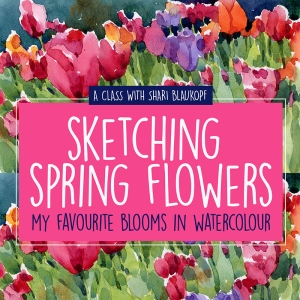


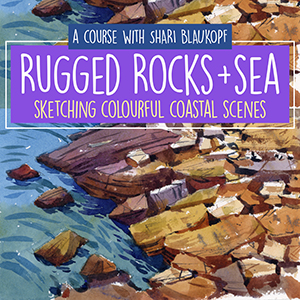


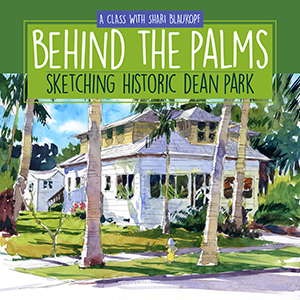

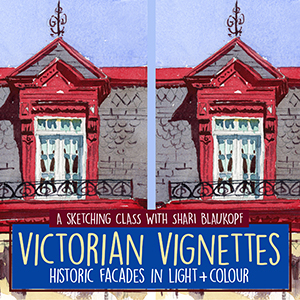

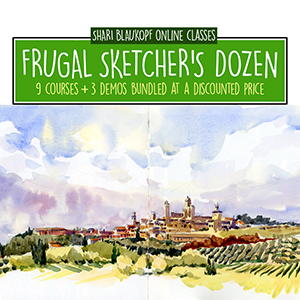


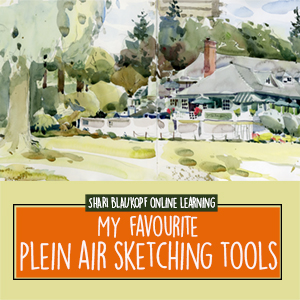


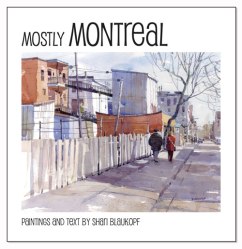


What a WONDERFUL tutorial! Thank you for sharing Shari! You surely make it look easier than it is 🙂
LikeLike
Thanks Jodi. I’m really glad you found it useful. I am just about to start my workshop season so this helps me clarify my thoughts for teaching too.
LikeLiked by 1 person
Thank you! Love your work. I’ve started sketching more than doing big paintings because of you! Lynn
LikeLike
That’s great to hear Lynn. Of course I hope you are still doing big paintings too!
LikeLike
Fantastic ! I really appreciate you showing us your method of work.
LikeLike
Thanks Ivana. Glad it was useful.
LikeLike
I’d love more of these step by step lessons. Thanks
LikeLike
When I have time I like to do these. There is another one today Reissa.
LikeLike
Lovely tutorial Shari it is always nice to see the steps by step sequence! Well done! 😉 Carolina
LikeLike
Glad you like it Carolina. Thanks for letting me know.
LikeLiked by 1 person
Is beautiful! 😉
LikeLike
Thanks for the toot 🙂
LikeLike
Glad you like it Sheila.
LikeLike
Magnificent!
LikeLike
Thanks John!
LikeLike
This was excellent Shari. Thanks for doing this. Green gold is a very useful shade. Also Perylene green. Key learnings from some people I have worked with.
LikeLike
I’m so glad you found it helpful Fred. Thanks for writing!
LikeLike
Thank you so much!
LikeLike
As always, thanks Monique.
LikeLike
Wonderful tutorial to match a wonderful sketch. Thanks Shari.
LikeLike
Thanks Tony. And now I can say “See you next month!”
LikeLike
Thank you for this! I am such a visual learner….. I guess we all are, or we wouldn’t be painting. 😊 This is very helpful.
LikeLike
I’m so glad you found it useful Karen. I love to do step-by-step tutorials when I have time. But that doesn’t happen too often.
LikeLike
I also want to thank you for this. You put a lot of time into these lessons. You’ve even made me want to paint trees which I didn’t think I would.
LikeLike
Judy, thanks for telling me this. I really appreciate it.
LikeLike
Wonderful, thanks Shari for sharing!
LikeLike
Thanks Tracey. Hope you are well!
LikeLike
That was my question too. Thanks for showing the layers and process
LikeLike
Glad you enjoyed the process Chris!
LikeLike
Shari thankyou so much this is invaluable and a great help on my very early journey into watercolours
LikeLike
I’m so glad you like it Valmae. It does help to see the steps, I know.
LikeLike
Thank you for sharing ….love your tree
LikeLike
Thanks Liliane!
LikeLike
Wow! This is fantastic! Thanks so much for sharing this Shari! So incredibly helpful! Love it! 😍
LikeLike
Many thanks Charlie. I always love to hear from you.
LikeLiked by 1 person
Love! Love! Love!! I am always in awe of how you do your trees, so this was the perfect subject! 🙂 I really love the color combination you used to get the lightest color for the tree, it reminds me of the DS color Buff Titanium. Do you remember what mix you used to get that creamy neutral color on the tree?
LikeLike
Thanks. Thanks. Thanks. It’s funny. I have a tube of Buff Titanium but I haven’t used it yet. the mix on the tree is likely a diluted mix of burnt sienna, raw sienna and ultramarine. Maybe a bit of yellow thrown in for warmth.
LikeLike
Thanks!! I love to use Buff Titanium for animal paintings. 🙂
LikeLike
Thanks so much for this Shari – it’s so enlightening, especially for a watercolours beginner. I would love it if you were to do a book on watercolours!
LikeLike
I would love to do a book too Catherine. But I have a full-time teaching job which makes big projects like that near-impossible. I would have to take a sabbatical to do anything of that scope. Maybe one day, when I retire…
LikeLike
Yes, thank you Shari! I am intrigued by the step by step instructions. It is so helpful to see the start to finish painting. As always, you have a winner!!
LikeLike
Thanks for writing Linda. I think everyone loves to see the step-by-step tutorials. I know I do when I can find them online. It really helps to understand the layers in watercolour.
LikeLike
wow, thank you Shari, that really helps.I am an old airbrush teacher and I always taught in color “layers” like this it’s very helpful. Much Aloha, Deb
LikeLike
Wow, what happens to old airbrush teachers. Do they learn Photoshop? You must have had to retrain, I guess. At least that’s what most airbrush artists I know had to do.
LikeLike
It is wonderful to see this done step by step! Thanks.
LikeLike
Thanks Joan!
LikeLike
Thank you for this very helpful tutorial, Shari. I know it takes time and breaks your momentum for you to stop and photograph each step, but I hope you will do this again. In some ways , it is better than a video because we can visit each stage and focus on it as long as we need to. The iPhone photos are just fine, shadows and all …. spontaneous and simple often can lead to very satisfactory results. We love it.
Thanks to Fred too for requesting this. Great idea.
LikeLike
Hi Louise. It’s not really much of a bother to do these. I usually take the photos when a wash is drying, so it fits in well with the process. There’s another one online today. Thanks again to Fred for the suggestion which has proved to be quite popular with blog readers.
LikeLike
Such a helpful tutorial–thank you for sharing!
LikeLike
Thanks Kari. Glad you liked it.
LikeLike
Thanks for the tutorial. I just came back from painting trip in Charlevoix with Martha Markowsky’s group. I was doing mainly sketching and a little bit of waiter color. I still need lots of practice,
Beautiful tree.
LikeLike
I am envious of you guys. I love Charlevoix. Hope you had a wonderful time Andre.
LikeLike
I keep coming back to this tutorial, I think it’s the fifth time since you’ve posted it. I’m trying to get used to think the picture before doing it, and this is really quite elegant thinking.
Thank you very much for sharing.
LikeLike
Thanks so much for writing Delphine. I am really glad you find it helpful. One thing I learned at a Tom Hoffmann workshop was to keep it abstract as long as possible. I always have that in my head as I paint and it helps me a lot.
LikeLike
What a great advice! I will remember it,thanks.
LikeLike
Thankyou!
LikeLike
Thanks Sandi!
LikeLike
You are my hero for putting this on the site– So helpful. I wish I could follow u everywhere you go!!! Hope NYC was great
Lisa
LikeLike
New York was great and we missed you. At least I did. Hopefully you will be able to join us one of these days Lisa.
LikeLike
Thank you for the step-by-step and excellent and clear explanation. Ity helps a great deal to be taken through your process. Lovely result.
LikeLiked by 1 person
Thanks so much for writing Janice!
LikeLike
I really liked having the big tree boiled down to 5 steps. I will try to simplify my approach, based on how you worked on it…I love your result.
LikeLiked by 1 person
Do you let the colors dry completely between each step? I noticed that the approach you used here is different than that you used for the Hawthorne recently. I’m trying to find a good approach for doing the background, and have a tough time deciding whether to go from back to front, or separate the two, like you have done here.
LikeLike